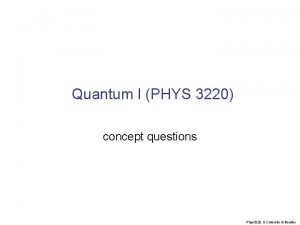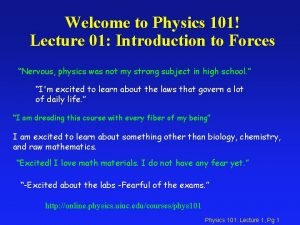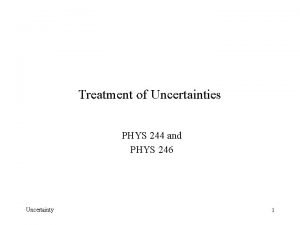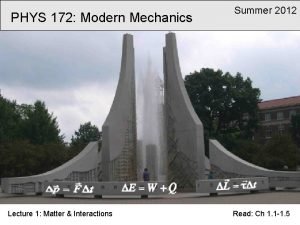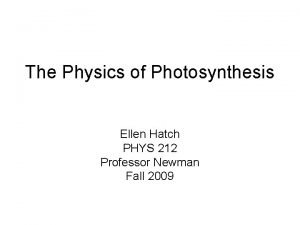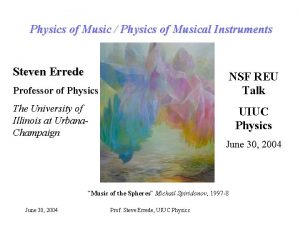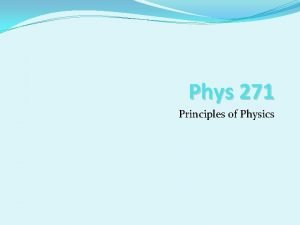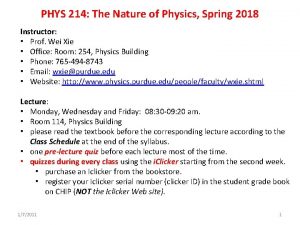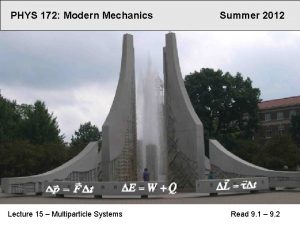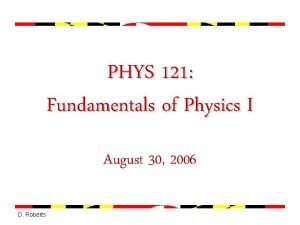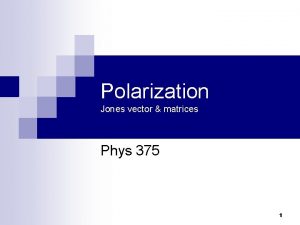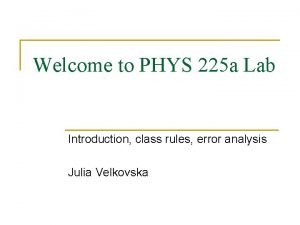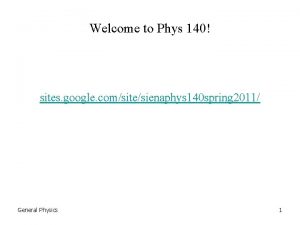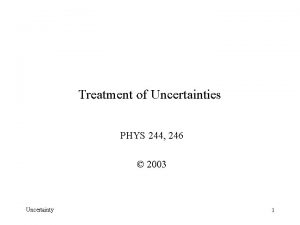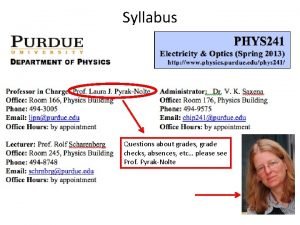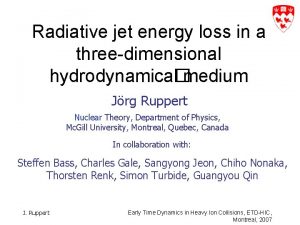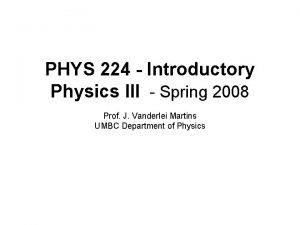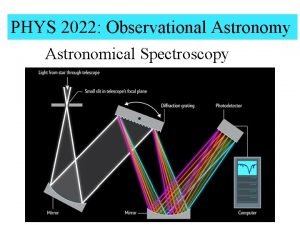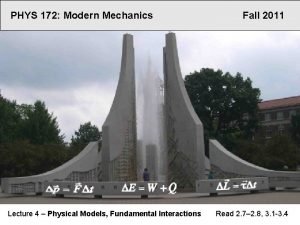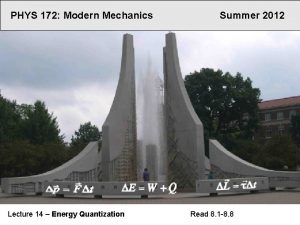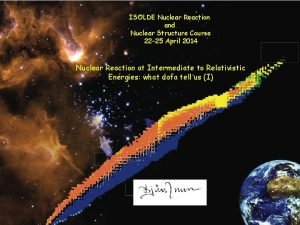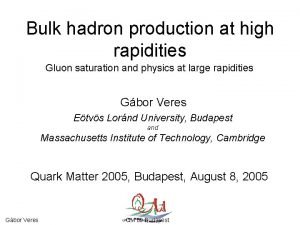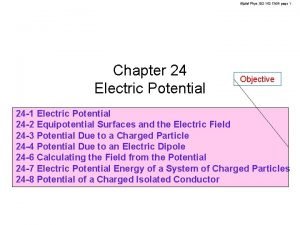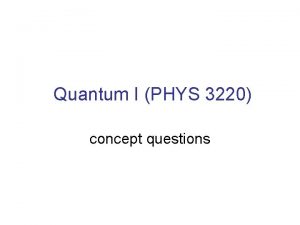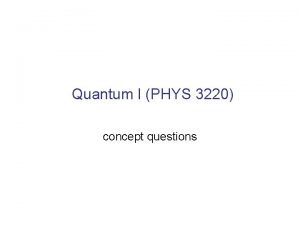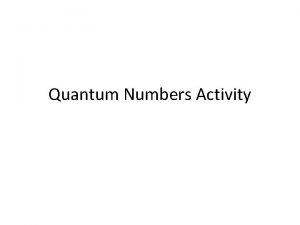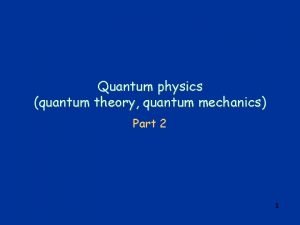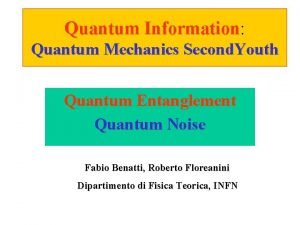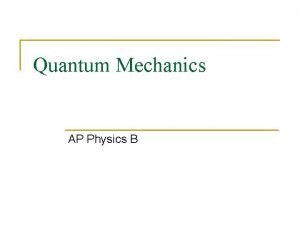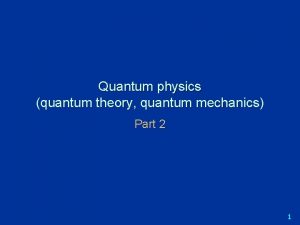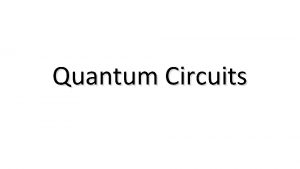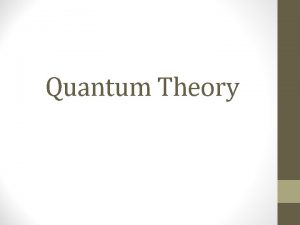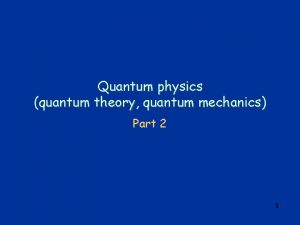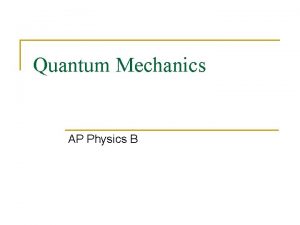Quantum I PHYS 3220 concept questions Phys 3220






















































- Slides: 54

Quantum I (PHYS 3220) concept questions Phys 3220, Michael Dubson U. Colorado at Boulder

Operators,

A wavefunction y(x) has been expressed as a sum of energy eigenfunctions (un(x)’s): Compared to the original y(x), the set of numbers {c 1, c 2, c 3, …. } contains: A) more information. B) less information. C) the same information D) cannot be determined/depends. 1

Consider a complex vector V: Where V 1 and V 2 are complex numbers (they are the “components of V”) If we want the inner product of V with itself, <V|V>, to be positive (for nonzero V), what should <A|B> be? A) A 1 B 1 +A 2 B) A*1 B 1 +A*2 B 2 C)|A 1 B 1 +A 2 B 2| D) More than one of these options E) NONE of these makes sense. 1

If f(x) and g(x) are wave functions, and c is a constant, then <c f|g> = ? A) c<f|g> B) c*<f|g> C) |c|<f|g> D) c<f*|g> E) None of these 60

A vector can be written as a column of its components; likewise a vector in Hilbert space (a wave function) can be written as an infinite column of its components in a basis of the uns: The dot product of two vectors A and B is: The inner product of two wavefunctions, A) D) 59 B) C) E) something else!

Do you plan to attend today’s Tutorial (on “functions as vectors”) A) Yes, at 3 pm B) Yes, at 4 pm C) Perhaps, more likely at 3 D) Perhaps, more likely at 4 E) No, can’t come/not planning on it.

Do the set of all normalized wave functions form a vector space? A) Yes B) No 74

A wavefunction y(x) has been expressed as a sum of energy eigenfunctions (un(x)’s): Viewing y(x) as a vector in Hilbert space, what role do the cn’s and un’s play? : A) un’s are basis vectors, cn’s are norms of vectors B) un’s are components, cn’s are norms of vectors C) un’s are basis vectors, cn’s are components D) un’s are components, cn’s are basis vectors E) Something else/I don’t understand 1

A wavefunction y(x) has been expressed as a sum of energy eigenfunctions (un(x)’s): Viewing |y> as a vector in Hilbert space, what role do the cn’s and |un>’s play? : A) un’s are basis vectors, cn’s are norms of vectors B) un’s are components, cn’s are norms of vectors C) un’s are basis vectors, cn’s are components D) un’s are components, cn’s are basis vectors E) Something else/I don’t understand 1

If a wave function, f(x) is square-integrable does that mean that f(x) is always normalizable? That is, can we always find a number, A, such that) A) Yes B) No 79

True (A) or False (B): The operator i (i. e. multiplying by the constant i = -1) is a hermitian operator. 61

A) Yes B) No 64

True (A) or False (B): If f(x) is a wave function, then 62

True Always (A), False Always (B) or True Sometimes (C): 63

Given that Q is a Hermitian operator, what can you say about <Q 2>, i. e. ? A) It will be real if and only if Y is a stationary state (eigenstate of H) B) It will be real if and only if Y is an eigenstate of Q. C) It must be real, and = <Q>2 D) It must be real, but cannot = <Q>2 E) It must be real, and may or may not =<Q>2

Suppose |f 1> and |f 2> are eigenvectors of operator Q, with eigenvalues q 1 and q 2 respectively. Is a|f 1>+b|f 2> an eigenvector of Q? A) Yes, always B) No, never C) Only if a=b D) Only if q 1=q 2 E) Not sure/something else/? ? ?

In the simple harmonic oscillator, the eigenvalues of H are En=ħw(n+1/2), and a measurement of energy will always observe one of these values. What can we say about <H>? A) It must always be one of the En B) It will never be one of the En C) It is sometimes one of the En, but only for a stationary state D) It is sometimes one of the En, not necessarily for a stationary state E) Something else!

Postulate 3: A measurement of observable “O” can only result in one of the eigenvalues of Ô If we measure the momentum of a free particle in 1 D, what outcomes are possible? A) Any real value is possible B) Any positive value is possible C) Any value is possible (including complex values) D) Only integer values are possible E) For a given particle, there is only ONE possible value (or perhaps 2, ±p 0) To think about: What if we measure x instead of p?

WHITEBOARDS: Come up with two different normalized states, ψ(x), for a particle in a harmonic oscillator potential, such that the probability of measuring E 0 (ground state energy) is exactly 1/3. For each state you come up with, what is <H>? (To think about if you have time: If I give you the value of <H>, is your ψ(x) uniquely determined? How does your state evolve with time, ψ(x, t)? Given only that Prob(E 0)=1/3, what is the range of all possible <H>’s?

Suppose we take the particle in the state you came up with, measure H, and happen to get E 0, (the energy of the ground state. ) Sketch |ψ(x)|^2 immediately after measurement. What happens as time goes by? If you have time, resketch if… … you had been given a particle, measured H, and happened to get E 1 (the energy of the first excited state? ) … you had been given a particle, measured x, and happened to get x=0 (to high precision!)

Observable A is measured, and the value a 1 is found. What is the system's state immediately after measurement? A) D) 71 B) E) C)

Immediately after the measurement of A, the observable B is measured. What is the probability that b 1 will be found? A) 0 72 B) 1 C) 0. 5 D) 2/√ 13 E) 4/13

If the grad student failed to measure B, but instead measured A for a second time, what is the probability that the second measurement will yield a 1? A) 0 73 B) 1 C) 0. 5 D) 2/√ 13 E) 4/13

A system is in a state which is a linear combination of the n=1 and n=2 energy eigenstates What is the probability that a measurement of energy will yield energy E 1? A) B) 1/√ 2 E) Something else! 66 C) 1/2 D) 1/4

You measure the energy of a particle in a simple harmonic oscillator, and find E 1 (i. e. the first excited energy, 3/2 ħω) Which graph best represents |ψ(x)|^2 immediately after the measurement? To think about: how does the plot evolve in time? A) B) C) D) Or E) None of these is remotely correct.

If we change the potential V(x), do the eigenvectors of x change? (i. e. , gx 0(x)) How about the eigenvectors of p (i. e. , fp 0 (x))? A) gx 0 will change, and so will fp 0 B) gx 0 will change, but fp 0 will NOT C) gx 0 will NOT change, but fp 0 will D) Neither gx 0 nor fp 0 will change E) It depends!!

Suppose Ψ(x, t) is known to be an energy eigenstate (state n): Can that energy eigenstate be written as A) Yes B) No C) Maybe 78

Do the set of delta-functions, d(x-x 0) (for all values of x 0), form a complete set? That is, can any function f(x) in the Hilbert Space be written as a linear combination of the delta function like so: A) Yes B) No (If you answer Yes, you should be able to construct the function F(x 0). ) 75

An isolated system evolves with time according to the TDSE with V = V(x). The wave function Ψ = Ψ(x, t) depends on time. Does the expectation value of the energy <Ĥ> depend on time? A) Yes, always B) No, never C) Sometimes, depending on initial conditions 69

A system (described by PE = V(x)) is in state Ψ(x, t) when a measure of the energy is made. The probability that the measured energy will be the nth eigenvalue En is Does the probability of finding the energy = En when the system is in state Ψ(x, t) depend on the time t of the measurement? A) Yes 67 B) No

Can the wave function Ψ(x, t) describing an arbitrary physical state always be written in the form where un(x) and En are solutions of A) Yes 76 B) No

A system (described by PE = V(x)) is in state Ψ(x, t) when a measurement of the energy is made. Does the probability of finding the energy = En depend on the time t of the measurement? A) Yes B) No C) Depends on Ψ(x, 0) D) Depends on V(x) 67

Given two quantum states labeled |f> and |g>, which relation below must be true? A) <f|f> <g|g> ≥ |<f|g>|2 B) <f|f> <g|g> ≤ |<f|g>|2 C) <f|f> <g|g> = |<f|g>|2 D) None of the above is guaranteed, it depends on the states f and g. 67

In general, given Hermitian operators A and B, and a state y, (and with the usual notation <A>=<y|A|y> what can you say about <y| <A> B | y> =? A) <AB> B) <BA> C) <B><A> D) MORE than one of these is correct! E) NONE of these is, in general, correct! 67

A) Yes B) No 92

A) Zero always B) Non-zero always C) Zero or non-zero depending on the details of the eigenfunction, Y 1 90

Is s. As. B zero or non-zero? A) Zero B) Non-zero C) Zero or non-zero depending on details of the state function Y used to compute σA σB 91

Consider a Hamiltonian such as, What is the value of? A) Zero always B) Non-zero always C) Zero or non-zero depending on Y. 87

Consider a Hamiltonian such as, What is the value of? A) Zero always B) Non-zero always C) Zero or non-zero depending on Y. 87

What is the value of, where the operator is defined as for any wave function, Y. A) Zero always B) Non-zero always C) Zero or non-zero depending on Y. 88

A) Yes B) No 89

If you have a single physical system with an unknown wave function, Y, can you determine experimentally? A) Yes B) No 93

If you have a system initially with some state function Y, and then you make a measurement of the energy and find energy E, how long will it take, after the energy measurement, for the expectation value of the position to change significantly? A) Forever, <x> is a constant B) ħ/E C) neither of these 94

Complex number z = a + ib. What is the value of A) a 2 + b 2 B) a C) b D) 1 E) 0 70

The wave function Ψ(x, t) below is a solution to the time-independent Schrödinger equation for an infinite square well that goes from 0 to 1. How many energy eigenstates of the system have nonzero amplitude? 77 A) 1 B) 2 C) 3 or more D) Not enough info

Do the set of bras corresponding to the kets form a vector space? A) Yes B) No 122

Consider the object formed by placing a ket to the left of a bra like so: . This thing is best described as. . . A) nonsense. This is a meaningless combination. B) a functional (transforms a function or ket into a number). C) a function (transforms a number into a number). D) an operator (transforms a function or ket into another function or ket). E) None of these. 123

Consider the object formed by placing a bra to the left of a operator like so: . This thing is best described as. . . A) nonsense. This is a meaningless combination. B) a functional (transforms a function or ket into a number). C) a function (transforms a number into a number). D) an operator (transforms a function or ket into another function or ket). E) None of these. 124

The hermitean conjugate or adjoint of an operator , written ("A-dagger") is defined by is hermitean or self-adjoint if An operator . , that is, if where Consider is hermitean. What is adjoint of ? A) (R is hermitian) B) C) D) None of these Hint: we are looking for the operator 125 such that , the

Consider the state What is , where is the projection operator for the state A) c 2 B) C) D) E) 0 126 . ?

Consider the state What is , where A) B) C) 0 D) E) None of these 127 . ?

If the state the basis states the state A) normalized. B) not normalized. 128 as well as and are normalized, then is

A particle in a 1 D Harmonic oscillator is in the state where un(x) is the nth energy eigenstate . A measurement of the energy is made. What is the probability that result of the measurement is the value Em ? A) B) C) D) 119 E) cm
 Quantumi
Quantumi Classical physics
Classical physics Quantum physics vs mechanics
Quantum physics vs mechanics Itec 3220
Itec 3220 Cs 3220
Cs 3220 Comp 3220
Comp 3220 Hadi esmaeilzadeh
Hadi esmaeilzadeh Itec 3220
Itec 3220 Itec 3220
Itec 3220 Cs 3220
Cs 3220 Cs 3220 gatech
Cs 3220 gatech Cs 3220 gatech
Cs 3220 gatech Uiuc physics 102
Uiuc physics 102 Taekjip
Taekjip Ucsd physics courses
Ucsd physics courses Percent difference formula
Percent difference formula Phys 172
Phys 172 Phys 241 lecture quizzes
Phys 241 lecture quizzes Http //www.phys.hawaii.edu/ teb/optics/java/slitdiffr/
Http //www.phys.hawaii.edu/ teb/optics/java/slitdiffr/ Http //www.phys.hawaii.edu/ teb/optics/java/slitdiffr/
Http //www.phys.hawaii.edu/ teb/optics/java/slitdiffr/ Phys 212 equation sheet
Phys 212 equation sheet Phys 398 uiuc
Phys 398 uiuc Units for charge in physics
Units for charge in physics Att phys medical abbreviation
Att phys medical abbreviation Hex root words
Hex root words Mastering physics login
Mastering physics login Phys 214
Phys 214 Particl clicker
Particl clicker Phys 121 umd
Phys 121 umd Eosc 114 ubc
Eosc 114 ubc Jones matrix for half wave plate
Jones matrix for half wave plate Phys 101 uiuc
Phys 101 uiuc Phys 225
Phys 225 Phys140
Phys140 Phys 244
Phys 244 Purdue phys 241
Purdue phys 241 Chiho nonaka
Chiho nonaka Saturn facts
Saturn facts Phys 214
Phys 214 Phys 214
Phys 214 Ucsd physics courses
Ucsd physics courses Phys 272 purdue
Phys 272 purdue Phys 224
Phys 224 Astronomy
Astronomy Phys 172
Phys 172 Phys 172
Phys 172 Phys 142
Phys 142 Phys. rev. c
Phys. rev. c Tsms phys ed
Tsms phys ed Phys. rev. c
Phys. rev. c Aljalal phys 102
Aljalal phys 102 Aljalal phys 102
Aljalal phys 102 Ideal self and real self psychology
Ideal self and real self psychology Perbedaan pemasaran dan penjualan
Perbedaan pemasaran dan penjualan Icq and ccq meaning
Icq and ccq meaning
